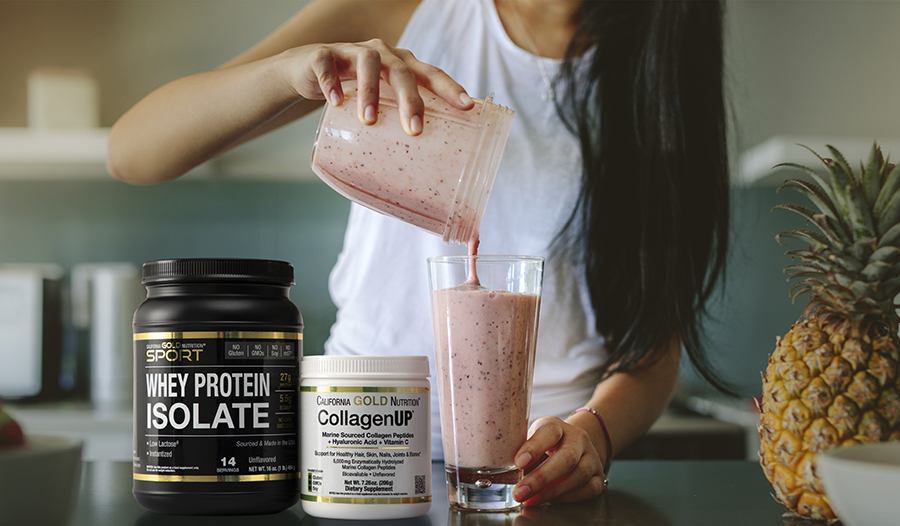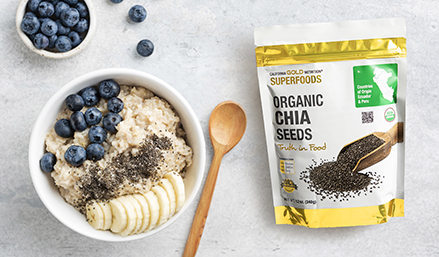4 odżywcze przepisy na przerwanie postu

"Post jest najwspanialszą naturalną terapią leczniczą. Jest to starożytne, uniwersalne "lekarstwo" natury na wiele problemów." - Elson M. Haas, M.D.
Przerywany post jest jednym z najgorętszych trendów dietetycznych. Wygoogluj to, a otrzymasz ponad 77 milionów trafień! Choć może się to wydawać modne, sam post jest starożytną praktyką, która jest wykorzystywana dla zdrowia duchowego i fizycznego od tysięcy lat.
Liczne religie i dyscypliny duchowe, takie jak joga, włączają do swoich praktyk krótkoterminowe (trwające kilka godzin) lub długoterminowe posty (trwające tygodniami, zwykle z posiłkami spożywanymi w nocy). Duchowe korzyści mogą obejmować zwiększoną klarowność, naładowanie boskich baterii i zwiększenie współczucia dla ludzi w potrzebie.
4 popularne sposoby na przerywany post
Post pociąga za sobą dobrowolne powstrzymanie się od jedzenia lub picia (lub obu). Przeprowadzany przez określony czas post może być całkowity lub częściowy (np. tylko spożywanie soków) i może trwać długo lub krótko.
Przerywany post odnosi się do wielu różnych harmonogramów posiłków, w których następuje cykl między dobrowolnym postem a jedzeniem w określonym czasie. Główna różnica między przerywanym postem a innymi podejściami dietetycznymi, takimi jak liczenie kalorii lub keto, polega na tym, że skupiasz się na tym, kiedy jesz, a nie na tym, co jesz.
Istnieje wiele różnych reżimów przerywanego postu. Cztery najpopularniejsze z nich to:
- Post nocny: Najłatwiejsze podejście; masz 12-godzinne okno na jedzenie i 12-godzinne okno na post.
- 5:2 lub 6:1 Fast: Jesz regularnie 5 lub 6 dni w tygodniu i lekko (500-600 kalorii dziennie) 1-2 dni w tygodniu.
- Metoda 16/8: Pościsz przez 14-16 godzin i jesz przez 8-10 godzin. Najprostszym sposobem jest pominięcie śniadania i zaprzestanie jedzenia po godzinie 20:00 .
- Całodzienny post: Jesz jeden posiłek dziennie 1-2 razy w tygodniu i regularnie przez 5-6 dni.
Korzyści zdrowotne wynikające z postu
Według dr Elsona Haasa, jednego z wiodących praktyków medycyny integracyjnej, korzyści płynące z postu obejmują zwiększoną energię, czystszą skórę, utratę wagi, odmłodzenie, silniejszy układ odpornościowy i lepszy sen. Kiedy pościsz, dajesz odpocząć swojemu układowi trawiennemu i uwalniasz energię, która może być skierowana na eliminację toksyn z okrężnicy, nerek, pęcherza moczowego, płuc i skóry. Post promuje również autofagię, proces, w którym niepotrzebne lub uszkodzone komórki są usuwane.
Chociaż potrzeba więcej badań, badania wykazały, że przerywany post może przynieść liczne korzyści metaboliczne. Obejmują one zmniejszenie masy ciała i tkanki tłuszczowej, poprawę lipidów we krwi, obniżenie ciśnienia krwi i lepszą regulację poziomu cukru we krwi.
Badania wykazały również, że post może zmniejszyć stan zapalny, który jest normalnym procesem immunologicznym, który może mieć negatywny wpływ na zdrowie, zwiększając ryzyko raka, chorób serca i reumatoidalnego zapalenia stawów. Badania na zwierzętach wykazały, że post może poprawić zdrowie mózgu i zwiększyć długowieczność.
Wskazówki dotyczące postu
Jeśli dopiero zaczynasz pościć, zamiast pościć cały dzień bez jedzenia, zacznij od krótkiego postu, np. przez 12 godzin. Może to pomóc uniknąć typowych działań niepożądanych, takich jak uczucie zmęczenia, głodu lub nastroju.
Upewnij się, że jesteś nawodniony, pijąc dużo wody. Jest to szczególnie ważne, ponieważ pragnienie można łatwo pomylić z głodem. Podczas okresów postu można swobodnie spożywać napoje bezkaloryczne, takie jak czarna kawa lub herbata. . Odrobina kofeiny może pomóc utrzymać koncentrację i energię podczas szybkich okresów.
Ponieważ jesz mniej, ważne jest, aby spożywać żywność wysokiej jakości, a nie puste kalorie. Oznacza to spożywanie dużej ilości pełnowartościowych pokarmów roślinnych, w tym owoców, warzyw, fasoli, orzechów i nasion, oraz produktów pełnoziarnistych. i produktów pełnoziarnistych. Pokarmy te są nie tylko bogate w składniki odżywcze, ale zawierają również błonnik. , który pomoże ci dłużej pozostać sytym.
Aby zminimalizować utratę mięśni i zmaksymalizować sytość, należy spożywać odpowiednią ilość białka. Możesz także chcieć przyjmować multiwitaminę i suplement mineralny z posiłkami, które zawierają zalecane RDA dla twojego wieku i płci, aby upewnić się, że spełniasz swoje wymagania żywieniowe.
Dobrym pomysłem jest omówienie postu z lekarzem, szczególnie jeśli rozważasz dłuższy post. Kobiety w ciąży lub karmiące piersią, osoby z cukrzycą lub osoby z zaburzeniami odżywiania w wywiadzie prawdopodobnie nie powinny próbować pościć.
Co jeść, aby przerwać post
Aby jelita były zadowolone, zminimalizować skoki poziomu cukru we krwi i przejść do stanu odżywienia po poście, jedz małe porcje lekkostrawnych pokarmów. Chociaż głód może kusić do sięgania po pokarmy bogate w tłuszcze, rafinowane węglowodany i cukier - takie jak pizza, ciastka lub makaron z serem - może to powodować ból brzucha i wzdęcia. Jeśli sięgasz po wysokokaloryczne śmieciowe jedzenie podczas okien żywieniowych, nie będziesz tak skłonny do utraty wagi.
Doskonałym wyborem na przerwanie postu są bogate w składniki odżywcze, lekkostrawne owoce (daktyle są ulubionym pożywieniem na Bliskim Wschodzie), sfermentowane pokarmy, takie jak niesłodzony jogurt lub kiszona kapusta, zdrowe tłuszcze, takie jak awokado, i lekkostrawne białka, takie jak bulion kostny, jajka i ryby w puszkach pakowane w wodzie, takie jak lekki tuńczyk lub łosoś alaskański. Kitchari, ajurwedyjska owsianka wykonana z fasoli mung, ryżu i przypraw równoważących poziom cukru we krwi, takich jak imbir , jest również dobrą opcją na przerwanie postu.
Oto cztery z moich ulubionych przepisów, które pozwolą ci przełamać post.
1. Przepis na kolagenowe jagodowo-bananowe smoothie
Serwuje 1
Koktajle to świetny sposób na uzupełnienie energii po poście, ponieważ są pożywne, sycące, lekkostrawne i proste w przygotowaniu. Ten jest bogaty w superfoods, takie jak nasiona chia , nasiona lnu , siemię lniane , śruty kakaowe , kolagen i jagody. Cynamon może pomóc zrównoważyć poziom cukru we krwi, ograniczając apetyt i pomagając dłużej czuć się sytym. Niektóre badania pokazują, że kolagen może zwiększyć masę mięśniową (która może być katabolizowana podczas postu), zmniejszyć utratę masy kostnej i poprawić wygląd skóry. Składniki można dowolnie modyfikować w zależności od upodobań.
Składniki:
- 1 szklanka mleka migdałowego lub owsianego
- 1 miarka białka w proszku (serwatka, soja lub groch)
- 1 porcja kolagenu w proszku
- 1/2 banana
- 1/2 szklanki jagód
- 1/4 łyżeczki cynamonu
- 1 łyżka nasion chia
- 1 łyżka siemienia lnianego
- 1 łyżka śruty kakaowej
Instrukcje:
Połącz wszystkie składniki w blenderze lub urządzeniu do smoothie i miksuj, aż dobrze się połączą.
2. Przepis na sałatkę z komosy ryżowej, ciecierzycy i łososia
Serwuje 2
Ta sałatka ma wszystko - złożone węglowodany z komosy ryżowej i ciecierzycy oraz chude białko i kwasy tłuszczowe omega-3 z łososia. Jest to lekkostrawny, sycący posiłek, który uzupełni organizm po poście. Podawać z ciemnymi, liściastymi warzywami, aby zwiększyć gęstość odżywczą posiłku. Zamiast łososia można użyć tuńczyka z puszki. W opcji wegańskiej pomiń rybę.
Składniki:
Dressing:
- 2 łyżki oliwy z oliwek extra vergine
- 1 łyżka octu balsamicznego
- 1/2 łyżeczki mieszanki suszonych Włoskie zioła
- 1/8 łyżeczki czosnku w proszku
Sałatka:
- 1/2 szklanki komosy ryżowej
- 1/2 łyżeczki soli morskiej lub himalajskiej różowej
- 1 puszka dzikiego łososia o pojemności 7,5 uncji
- 1 puszka ciecierzycy o pojemności 14 uncji (odsączona i opłukana)
- 1 marchewka, pokrojona w kostkę
- 1 łodyga selera, pokrojona w kostkę
Instrukcje:
- W małej misce wymieszaj oliwę z oliwek, ocet balsamiczny, mieszankę włoskich ziół i czosnek w proszku.
- W małym rondelku wymieszaj komosę ryżową z 1 szklanką wody i solą. Doprowadzić do wrzenia. Zmniejszyć ogień do średnio niskiego i przykryć. Dusić do wchłonięcia wody, około 15 minut. Pozostawić do ostygnięcia.
- W dużej misce wymieszaj łososia, ciecierzycę, marchewkę, seler naciowy i ostudzoną komosę ryżową. Dodać dressing i dobrze wymieszać. Podawać na zielonych liściach.
3. Łatwy przepis na nocną owsiankę

Serwuje 2
Typowe potrawy śniadaniowe, takie jak bajgle, tosty z galaretką lub słodkie płatki zbożowe, mogą powodować gwałtowny wzrost poziomu cukru we krwi, czego zdecydowanie nie chcesz po poście. Płatki owsiane, ponieważ są bogate w błonnik i zawierają trochę białka, pomogą uniknąć skoków i spadków poziomu cukru we krwi. Orzechy i nasiona chia dostarczają zdrowych tłuszczów i białka, podczas gdy rodzynki dodają naturalnej słodyczy. Jogurt dostarcza probiotyków i więcej białka. Przygotuj płatki owsiane poprzedniego dnia, aby były gotowe na pierwszy posiłek w ciągu dnia. Eksperymentuj z ulubionymi zdrowymi dodatkami, takimi jak przyprawy (cynamon , kardamon lub gałka muszkatołowa), suszone owoce, masło orzechowe, orzechy lub nasiona . lub nasiona .
Składniki:
- 1 filiżanka płatków owsianych
- 2 łyżki nasion chia
- 1 szklanka mleka (krowiego, migdałowego lub owsianego)
- 1/4 szklanki jogurtu
- 2 łyżki rodzynek
- 1/4 łyżeczki wanilii
- Szczypta soli
Polewy: Cynamon, kardamon, gałka muszkatołowa, orzechy włoskie, migdały, orzechy pekan, pestki dyni, nasiona słonecznika, suszone lub świeże owoce.
Instrukcje:
- W misce lub słoiku wymieszaj płatki owsiane, nasiona chia, mleko, jogurt, rodzynki, wanilię i sól. Dobrze wymieszać do połączenia. Odstawić do lodówki na 2 godziny lub na noc.
- Podzielić na dwie miski. Dodaj wybrane dodatki i ciesz się smakiem.
4. Przepis na zupę warzywną z czerwonej soczewicy
Serwuje 4
Rozgrzewająca i sycąca zupa świetnie nadaje się do przerwania postu, ponieważ jest bogata w białko, węglowodany i gotowane warzywa, które są łatwe do strawienia. (Czerwona soczewica gotuje się krócej i jest łatwiejsza do strawienia niż soczewica brązowa). Zupa zawiera dużo błonnika, dzięki czemu zapewnia uczucie sytości w okresach postu. Kombu (warzywo morskie ) zawiera enzym, który rozkłada skrobię w fasoli zwaną oligosacharydami, dzięki czemu soczewica jest łatwiejsza do strawienia. Kminek i imbir również wspierają zdrowe trawienie. Aby uzyskać gęstszą, bardziej kremową zupę, przed dodaniem jarmużu połowę zupy należy zmiksować blenderem. Zupa dobrze się mrozi, więc przygotuj dużą porcję w weekend, aby zjeść ją później w ciągu tygodnia.
Składniki
- 2 łyżki oliwy z oliwek, plus dodatkowa do skropienia
- 1 duża cebula, posiekana
- 2 ząbki czosnku, rozdrobnione
- 1 łyżeczka mielonego kminku
- 1/2 łyżeczki mielonego imbiru
- 1 kwarta bulionu z kurczaka lub warzywnego
- 2 szklanki wody
- 1 filiżanka czerwonej soczewicy
- 1 pasek kombu
- 1 duża marchewka, pokrojona w kostkę
- Garść jarmużu, drobno posiekanego
- Sól i pieprz, do smaku
Instrukcje:
- W dużym garnku podgrzej 2 łyżki oliwy z oliwek na średnim ogniu. Dodaj cebulę i smaż, często mieszając, do uzyskania złotego koloru, około 4 minut. Dodaj czosnek i smaż przez kolejną minutę.
- Dodaj kminek i imbir i smaż przez kolejną minutę.
- Dodaj bulion, wodę, soczewicę, marchewkę i kombu. Doprowadź do wrzenia. Częściowo przykryj garnek. Zmniejsz ogień i gotuj na wolnym ogniu, aż soczewica będzie miękka, około 20 minut, mieszając od czasu do czasu. Dodaj jarmuż. Dodaj sól i pieprz do smaku.
- Podawaj skropione dodatkową oliwą z oliwek.
Referencje:
- Arnason TG, Bowen MW, Mansell KD. Wpływ przerywanego postu na markery zdrowia u osób z cukrzycą typu 2: Badanie pilotażowe. World J Diabetes. 2017;8(4):154-164. doi:10.4239/wjd.v8.i4.154
- Bhutani S, Klempel MC, Berger RA, Varady KA. Poprawa wskaźników ryzyka choroby niedokrwiennej serca poprzez post naprzemienny wiąże się z modulacją tkanki tłuszczowej. Obesity (Silver Spring). 2010;18(11):2152-2159. doi:10.1038/oby.2010.54
- Faris MA, Kacimi S, Al-Kurd RA, et al. Przerywany post podczas Ramadanu osłabia cytokiny prozapalne i komórki odpornościowe u zdrowych osób. Nutr Res. 2012;32(12):947-955. doi:10.1016/j.nutres.2012.06.021
- Goodrick CL, Ingram DK, Reynolds MA, Freeman JR, Cider NL. Wpływ przerywanego karmienia na wzrost i długość życia szczurów. Gerontology. 1982;28(4):233-241. doi:10.1159/000212538
- Li L, Wang Z, Zuo Z. Przewlekły przerywany post poprawia funkcje poznawcze i struktury mózgu u myszy. PLoS One. 2013;8(6):e66069. Opublikowano 2013 Jun 3. doi:10.1371/journal.pone.0066069
WYŁĄCZENIE ODPOWIEDZIALNOŚCI:Celem niniejszej Strefy Zdrowia nie jest stawianie diagnoz...














































































 Spis treści
Spis treści
















